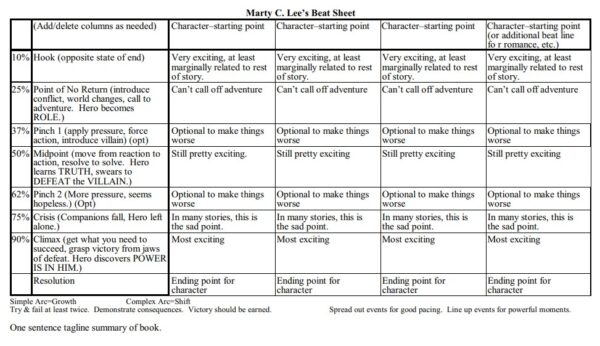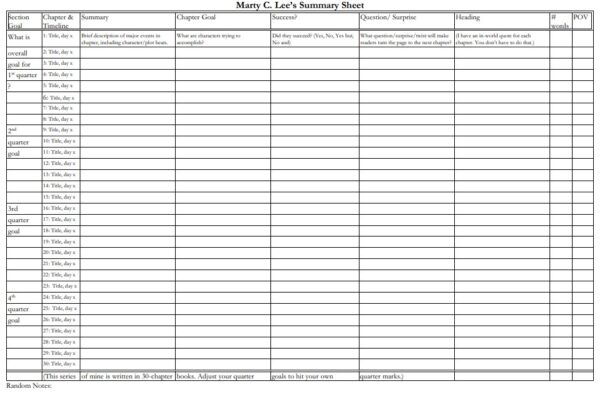Developing a Beat Sheet into an Outline — Guest: Marty C. Lee

As we’ve talked about many times here, we all have different writing processes because our brains all work differently. Some of us plot our stories in advance, and others of us write by the seat of our pants (otherwise known as “pantsing”).
Far from one method being better than another, whatever works for us is the right answer to “how should we draft our story?” In fact, most of us use a process somewhere in between the strict options of plotting or pantsing, whether we call it plotsing, plantsing, puzzling, or whatever.
However, anyone trying to discover the best drafting process for themselves might need to experiment with different ways of applying or merging the strengths and weaknesses of plotting and pantsing. The more alternatives we see along the plotter-pantser spectrum, the better we might understand what can work best for us.
To that end, Marty C. Lee joins us today to share how she develops story beats into a chapter-by-chapter outline. Whether her approach works for us or not, her explanation can give us ideas for our own drafting method.
Please welcome Marty C. Lee! *smile*
*****
How Can We Turn Our Story Concept into a Story Outline?
By Marty C. Lee
Even though Jami is a master plotter (who writes by pantsing, I hear), she admits that people learn and work in different ways and graciously allowed me to share my outlining method with you. (Thanks, Jami!) I’ll start with a brief history of my plotting evolution, so you can understand why I do what I do.
When I started writing, I thought I was a plotter.
I mean, I had a one-to-three sentence note for all six chapters of the short story I had in mind. Isn’t that an outline? (Those of you who actually outline can stop laughing now.)
But as I wrote and the middle of the story expanded, I had to keep bumping plot notes from one chapter to the next. By the time I finished my “short story,” I had a novel of 104,000 words that included all my original notes, plus a lot, lot more.
Does Our Story Have Structure?
Then I heard about plot beats and story structure. No worries. A story is structured however it is made, isn’t it? And I had beats. I could prove it…
I took several different story-structuring methods that mostly made sense to my warped brain and smooshed them together into my own little chart (which I will discuss later). Then I reverse-outlined every chapter of my book and marked every plot beat.
That proved something all right, but not that I had proper beats. So I revised the entire book.
Are Goals Pulling Our Story Forward?
Then I learned about chapter goals for characters and chapter page-turners. Did I even have those? So I created a second chart for my little reverse-outline.
It became very obvious why my story slowed down in the middle. I had four chapters that had the same (boring!) chapter goal.
Oh, sure, there was important stuff in the chapters. There was funny stuff. There was… too much stuff without something happening to make the reader care. After deleting half of those chapters and rewriting the rest, I had to redo my reverse-outline.
By the time I revised that book enough to be good (and 15,000 words shorter), I had outlined it so many times. Outlining up front—once—was becoming a more attractive option.
Next time, I could do better, right?
We Learn What Doesn’t Work
For my second book, I planned the beats in the handy chart I invented for reverse-outlining the first book. Then I got the book half-written (in random chunks), realized I was trying to stretch too little story over too much book, and had to redo half the organization.
What had been the midpoint moved to the first quarter, and a whole new event landed in the middle. And, thankfully, my plotting chart let me realize I had problems before I wrote the entire book wrong. Yay!
Discovering the best writing process for us often means figuring out what *doesn't* work Click To TweetI also noticed that one of the things that made me write more slowly for the first two books was trying to figure out the “steps” of a chapter as I was writing. Sure, I knew where I was going, but how do I get there?
So for book three, after completing my charts, I also tried outlining a little more detail for each chapter. After a little experimentation, I aimed for about 10% of the anticipated finished words for each chapter. (Your mileage may vary.)
Now it’s time to discuss my actual method…
How to Turn a Beat Sheet into a Chapter-by-Chapter Outline
As I describe it, I want you to keep one thing in mind: You can stop after any step that makes you feel ready to write.
Maybe you’ll make it all the way to the end. Maybe you won’t. You won’t hurt my feelings. *smile* Use what works for you.
Step #1: Define the Story Concept and Beats
First, I write down my concept. What’s the one or two sentences that tell me what my story is about? That goes below my Beat Sheet chart for reference.
(Note from Jami: Click on the image to view larger. Newsletter readers can click through to the post to view Marty’s Beat Sheet chart.)
Next, who are my point-of-view (POV) characters? I write with four POVs in my YA fantasy series, but this still works with only one POV. Each POV character gets a vertical column (and I add a column for anything special, like a romance subplot), while each beat point gets a horizontal row. (Stay with me, I’ll get to the beats.)
Now, looking at my concept sentence(s), how does each character end in the book? That goes in the last beat slot for “resolution.”
What is their opposite starting point (in some way)? That goes next to their name in the top row. The differences between the two rows are the character arcs.
Between the beginning and the resolution, I have seven beats. I have to hit:
- the Hook (10%)
- the Point of No Return (25%)
- the Midpoint (50%)
- the Crisis (75%)
- the Climax (90%)
Optionally, I can add Pinch Points at 37 and 62%. When I’m writing, those percentages are just estimates.
You may know these beats by other names or use other percentages. That’s okay. I have seen beat sheets with many more beats. (Jami has some great examples.) They tend to make my brain explode, so I stick with this list.
Step #2: Get Creative with Brainstorming
Now is crazy brainstorming time. What are some things that could happen in this story to my characters?
I make a list of as many ideas as I can think up, without discarding anything yet. Once I have a long list, I go through and mark events that could force my characters through their arcs, or that could turn the story in interesting ways, or that will just plain be exciting.
Next to the ideas I want to include, I write the name of the character most affected by that event. Then I play around with the events to see how they would work in different beats.
- The Climax should be the most exciting, physically and/or emotionally. (Emotionally is harder to write, but I prefer it.)
- The next most exciting beats should be the Hook and the Midpoint.
- Sometimes I just go with Pixar’s strategy: Everything gets worse until the end.
- Whether or not I include Pinch Points depends on how many great ideas make the cut.
By this point, the story is starting to come alive in my mind.
Step #3: Adjust If Multi-POV (Skip Step for Single POV)
Because I write multi-POV, I have another step that I started with book three.
- First, I highlight each character’s column in a different color and number the beats in order.
- Then I cut the chart into little pieces (one box per piece).
- I place the colored boxes in a rough sort of order, making characters take turns somehow.
I keep early beats before later beats for each character, but one character’s Midpoint might come before another’s Pinch Point, for instance. Whoever is the main POV for the book gets roughly half the chapters, and the rest are more or less evenly divided among the other three. (That is just my style for this particular series and might change in the future.)
I make sure the major beats are POV-centric, but some of the minor beats for one character might be seen through the eyes of another character if space requires. This part of my process tends to take a while as I arrange and rearrange. If you have a headache right about now, I unfortunately empathize.
Step #4: Add More Definition to Story Ideas
Once I have the order of events and POV settled, I start my Summary Sheet chart. (Remember, you can stop anywhere in the process you like.) The second chart contains a horizontal row for every chapter, and several vertical columns.
(Note from Jami: Click on the image to view larger. Newsletter readers can click through to the post to view Marty’s Summary Sheet chart.)
- Section Goal gets one entry per book quarter.
- The plot/character beats go in the Summary column, though sometimes they copy to the Question/Surprise column later.
- The Summary and POV columns are the ones I always fill out before I write, based on my first chart.
- Other than the chapter number, the Chapter/Timeline column stays blank for now.
- The other columns might not get filled out until I write, for story analysis as needed.
- Chapter Goal is for character goals, not author goals. What are the characters trying to accomplish in that chapter?
- Success means “did they get what they want?” and answers might include “yes” (rarely until the end), “yes, but (made it worse),” “no” (semi-rarely), and “no, and (made it worse).”
- The Question/Surprise column is where I look if my chapter endings are boring, and frequently derives from either the Summary or Success columns.
Step 4: Outline
Now I start my actual in-text outline. For each chapter in my new book file, I type whose POV it is in and the Summary/Beat info from the second chart.
How can we turn our story idea into an outline? Marty C. Lee shares her process Click To TweetThen I go back and brainstorm each chapter. “If this is the beat/chapter goal for the chapter, where does the chapter start? What are the characters trying to accomplish? What’s the setting? What happens first? Next? After that? What clues need to be in the chapter? Etc.”
I work in random order, with lots of bouncing around, until I have about 10% of my finished words in rough summary. (I’ve been known to write things like “they argue,” or “add emotion,” or “drama llama, struggle and smash” for a fight scene.)
What If This Isn’t For You?
Some of you pantsers might be cringing about now. That’s okay, you keep pantsing. I admire your crazy brain.
I started doing this because wandering was too time-consuming for me. You might have a better sense of direction than I do.
Whether we're plotters, pantsers, or something in between, we can often learn from other drafting methods Click To TweetEven with this outline, I still have enough wiggle room to make my pantsing brain happy. Sometimes my 10% outline ends up wrong and I wing the chapter anyway, but I know the most important parts to include.
Sometimes a little planned part expands unexpectedly. (“Oh, one of the diplomats is his cousin? He has a cousin? And she’s going to show up in the story again? Cool!”)
Some of you plotters might also be cringing. “My outline is half the length of my book,” you cry. “I hit twenty-five beats!” That’s okay. You keep plotting like a maniac. I admire your crazy brain, too.
I wish I were as organized as you. As for me, my crazy brain finds this mishmash of a method to be just about right.. *smile*
Whether you plot or pants, I wish you happy writing and a perfect amount of “outline.” ~ Marty C. Lee
*****

Marty C. Lee told stories for most of her life, but never took them seriously until her daughter asked her to write a particular one. The plotted six chapters grew to an entire novel, and now a young adult fantasy series is in progress.
Her characters take over her brain on a regular basis. If you catch her muttering to thin air, she’s probably arguing with one of her characters. She has learned to keep a notebook by her bed to jot down ideas so she can go to sleep and deal with them in the morning.
In between writing and spending time with her family, she reads, embroiders, gardens, and teaches small children at church. She prefers walking over bicycles or cars, because her feet are less scary. (If she walks, she can read at the same time, which is a nice bonus.)
You can download PDFs of her charts here and find her online at:
Website | Facebook | Bookbub | Goodreads
*****
About Wind of Choice:
 Ahjin has always dreamed of being a skydancer like his parents, and his time has finally come. But what should be the best day of his life quickly becomes the worst when he is condemned to a job he hates.
Ahjin has always dreamed of being a skydancer like his parents, and his time has finally come. But what should be the best day of his life quickly becomes the worst when he is condemned to a job he hates.
The sixteen-year-old winged boy is left with only one chance to win back his freedom and his dreams. All he has to do is to find and rescue a kidnapped god from the clutches of something powerful enough to kidnap a deity.
How hard could it be?
But when the other three gods also disappear, the elements run amok, and there’s more at stake than Ahjin’s dreams. With the help of a spunky gilled islander, a desert explorer, and a shapeshifting healer, Ahjin races against disaster to save his shattering world.
Fly, dive, and run through this enchanted story, full of twists and turns and unexpected friendships.
Amazon | Apple | Barnes & Noble | Kobo | All Retailers
*****
Thank you, Marty! As you mentioned, I’m a pantser, but one with a strong understanding of story structure to keep me on track. In other words, my brain is unique, and what works for me won’t necessarily work for others.
However, before we can explore our options, we first need to be aware of some of our other alternatives (even me—even though this style of outlining gives me hives *wink*). I know there’s not “one right way” to write, so I’m happy to share Marty’s drafting process just in case this method gives you ideas for how to improve your approach.
Note: If you prefer working with Excel spreadsheets rather than printing PDFs to fill out, you can download Excel versions of Marty’s charts here:
- Click to download Marty C. Lee’s Beat Sheet Chart
- Click to download Marty C. Lee’s Summary Sheet Chart
Do you consider yourself a plotter, pantser, or somewhere in between? How much detail do you figure out in advance? Have you ever created an outline? Does this method give you ideas for your drafting process? Do you have any questions for Marty?
Pin It


Thank you, Marty, for sharing your expertise in plotting. I’ve downloaded your forms in the hopes of tightening up my pantsing with some plot points/beats to make my writing stronger.
This is great. I would love to see a multi step-by-step process of this on YouTube or something like that actually showing a mock book using this. Thank you for posting
That’s an interesting idea, Tammy. I’ll have to think about that! 🙂
[…] post originally appeared as a guest spot on Jami Gold’s site. For her introduction or her many plotting resources, please visit her […]